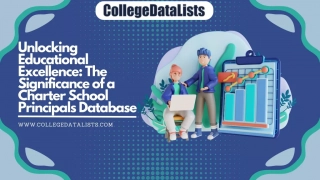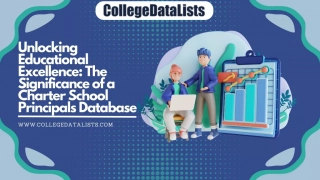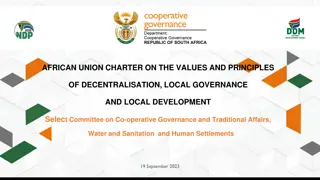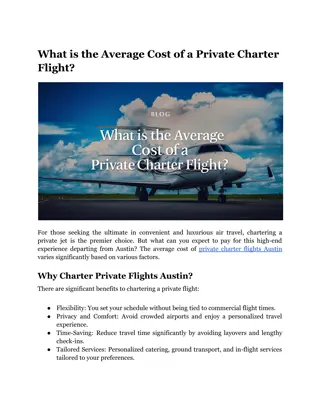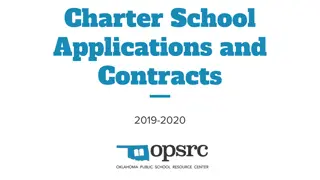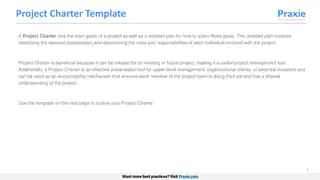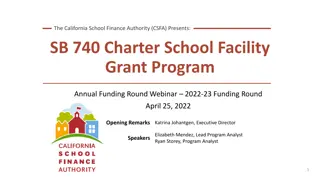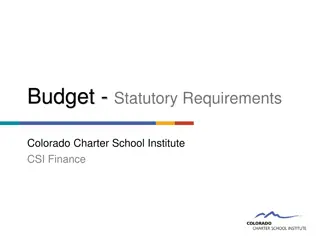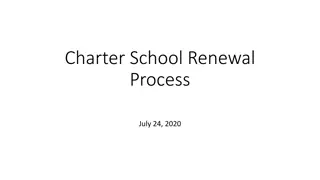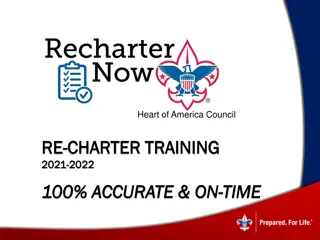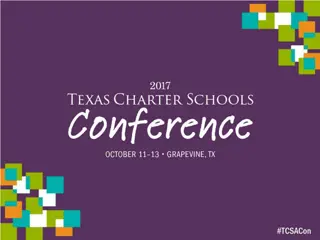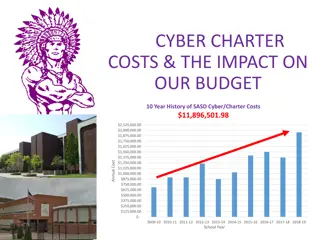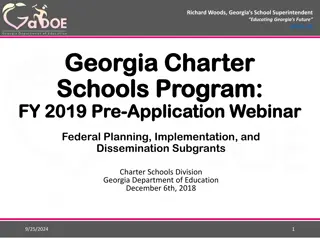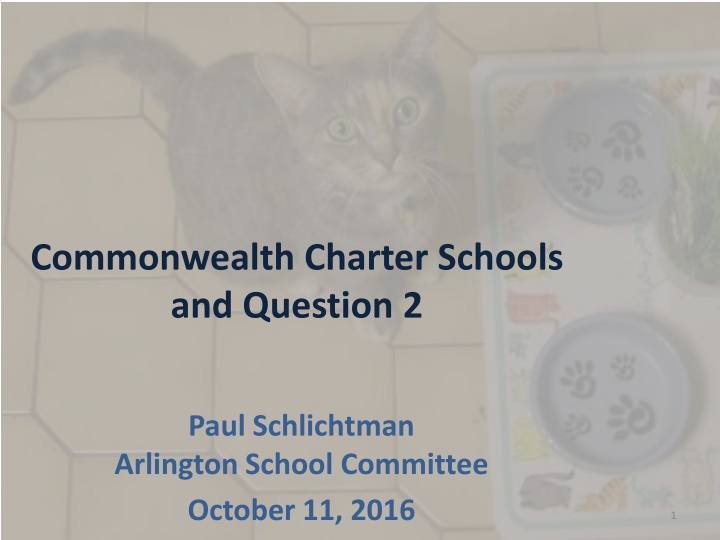
Charter Schools Question 2 and Fiscal Impact Analysis
Learn about the financial implications of Question 2 on charter schools in Massachusetts. Understand the potential effects on district budgets, tuition trends, and school funding if the proposed law is approved. Explore the data and projections regarding charter school enrollment and funding under the current cap system and the proposed changes.
Download Presentation

Please find below an Image/Link to download the presentation.
The content on the website is provided AS IS for your information and personal use only. It may not be sold, licensed, or shared on other websites without obtaining consent from the author. If you encounter any issues during the download, it is possible that the publisher has removed the file from their server.
You are allowed to download the files provided on this website for personal or commercial use, subject to the condition that they are used lawfully. All files are the property of their respective owners.
The content on the website is provided AS IS for your information and personal use only. It may not be sold, licensed, or shared on other websites without obtaining consent from the author.
E N D
Presentation Transcript
Commonwealth Charter Schools and Question 2 Paul Schlichtman Arlington School Committee October 11, 2016 1
The current charter school cap is really a plug in the fiscal drain. 100% 80% For most Massachusetts districts, the drain is plugged at 9% of Net School Spending. 60% 91% For the bottom 10% of districts the drain is plugged at 18% of Net School Spending. 82% 40% 20% If the per pupil charter school garnishment from local districts is cut in half, the number of available charter school seats would double. 0% -9% -18% -20% -40%
In FY 2017, Massachusetts DEFLATED the per-pupil foundation budget by -0.22% 9.00% 9.33% 8.00% In FY 2017, Net District Cost for Charter Schools (district garnishment after all reimbursements) increased from $412,811,820 to $451,338,729, a 9.33% increase. 7.00% 6.00% 5.00% 4.00% 3.00% This is happening to school districts under the current charter school cap. 2.00% 1.00% -0.22% Foundation budget inflation factor, FY17 A yes vote on Question 2, and 12 new charter schools every year, will make things much worse for children in our public schools. 0.00% Net District Cost for Charter Schools, FY17 -1.00%
Charter school tuition increases at a much greater rate than Chapter 70 aid 4
Charter Tuition Trends and Projections without Question 2 $1,000,000,000 $800,000,000 $600,000,000 Reimbursement $400,000,000 Net Cost to District $200,000,000 $0 FY98 FY05 FY12 FY19 FY96 FY97 FY99 FY00 FY01 FY02 FY03 FY04 FY06 FY07 FY08 FY09 FY10 FY11 FY13 FY14 FY15 FY16 FY17 FY18 FY20 -$200,000,000 5
Question 2: This proposed law would allow the state Board of Elementary and Secondary Education to approve up to 12 new charter schools or enrollment expansions in existing charter schools each year. Approvals under this law could expand statewide charter school enrollment by up to 1% of the total statewide public school enrollment (9,534) each year. New charters and enrollment expansions approved under this law would be exempt from existing limits on the number of charter schools, the number of students enrolled in them, and the amount of local school districts' spending allocated to them. If the Board received more than 12 applications in a single year from qualified applicants, then the proposed law would require it to give priority to proposed charter schools or enrollment expansions in districts where student performance on statewide assessments is in the bottom 25% of all districts in the previous two years and where demonstrated parent demand for additional public school options is greatest. New charter schools and enrollment expansions approved under this proposed law would be subject to the same approval standards as other charter schools, and to recruitment, retention, and multilingual outreach requirements that currently apply to some charter schools. Schools authorized under this law would be subject to annual performance reviews according to standards established by the Board. 6 The proposed law would take effect on January 1, 2017. (Source: MA Secretary of the Commonwealth)
Question 2: This proposed law would allow the state Board of Elementary and Secondary Education to approve up to 12 new charter schools or enrollment expansions in existing charter schools each year. Approvals under this law could expand statewide charter school enrollment by up to 1% of the total statewide public school enrollment (9,534) each year. 1% of current statewide enrollment: 9,534 students Statewide average charter tuition (FY17): $12,675.75 Potential annual impact of 12 new charters (FY17): $120,850,600 7
Charter Tuition Trends and Projections with Question 2 adding 12 additional charters in FY19 and FY20 $1,000,000,000 $800,000,000 $600,000,000 12 New Charters $400,000,000 Reimbursement Net Cost to District $200,000,000 $0 FY96 FY97 FY18 FY19 FY98 FY99 FY00 FY01 FY02 FY03 FY04 FY05 FY06 FY07 FY08 FY09 FY10 FY11 FY12 FY13 FY14 FY15 FY16 FY17 FY20 -$200,000,000 8
Lowell FY2017 Foundation Budget: $183,238,362 40000000 35000000 October 1, 2015 foundation enrollment determines FY2017 foundation budget. 30000000 25000000 20000000 15000000 10000000 5000000 0 -5000000 9
Lowell FY2017 Foundation Budget: $183,238,362 $40,000,000 $35,000,000 Out of district Special Education Foundation Budget $3,934,086 $30,000,000 $25,000,000 Actual Budget $11,533,797 $20,000,000 $15,000,000 Difference $7,599,711 $10,000,000 $5,000,000 $- -$5,000,000 10
Lowell FY2017 Foundation Budget: $183,238,362 $40,000,000 $35,000,000 In district Special Education Foundation Budget $14,584,644 $30,000,000 $25,000,000 Actual Budget $19,954,397 $20,000,000 $15,000,000 Difference $5,369,753 $10,000,000 $5,000,000 $- -$5,000,000 11
Comparing Lowell Public & Charter Per Pupil Costs, FY2017 $12,000 Charter Tuition, 1653 Charter Students $11,442 per pupil $18,880,662 $11,442 $10,000 1653 Lowell Public Schools Students $8,550 per pupil $14,133,150 If Educated In Lowell, $8,000 $8,550 $6,000 Difference: $4,747,512 $4,000 63 teachers Double the district s entire materials & supplies budget. $2,000 Universal PK additional $2 million $- 1 12
Arlington Town Meeting - 2015 ARTICLE 29 APPROPRIATION/COMMITTEES AND COMMISSIONS VOTED: (UNANIMOUS) That the sum of $25,695 be and hereby is appropriated to be expended by the following commissions, committees, and boards in the amounts indicated: A. Arlington Historical Commission $2,160 B. Historic District Commissions $5,100 (Avon Place Historic District Commission, Broadway Historic District Commission, Central Street Historic District commission, Jason/Gray Historic District Commission, Russell Historic District Commission, Pleasant Street Historic District Commission and Mount Gilboa/Crescent Hill Historic District Commission) C. Capital Planning Committee $0 D. Commission on Disability $3,000 E. Recycling Committee $3,000 F. Human Rights Commission $4,500 G. Arlington Tourism and Economic Development Committee - $1,775 H. Vision 2020 - $3,000 I. Transportation Advisory Committee - $0 J. Arlington Commission on Arts and Culture - $3,160 Said sums to be raised by general tax and expended under the direction of the various commissions, committees and boards. A true copy of the vote under Article 29 of the Warrant for the Annual Town Meeting of the Town of Arlington at the session held May 11, 2015. ATTEST: Town Clerk 13
Comparing Arlingtons Average Property Tax Bill to Charter Tuition, FY16 $10,000 Thus, according to common usage in the late Eighteenth Century, a duty to cherish was an obligation to support or nurture. Hence, the "duty . . . to cherish the interests of literature and the sciences, and all seminaries of them; especially . . . public schools and grammar schools in the towns" is an obligation to support or nurture these interests and institutions. $6,993 $5,000 $0 Median Single Family Tax Bill (FY16) Charter School Tuition (FY16) $5,000 $12,393 $10,000 JAMI MCDUFFY & others vs. SECRETARY OF THE EXECUTIVE OFFICE OF EDUCATION & others (and a companion case). 415 Mass. 545 $15,000 14
Regional Vocational Schools are self-governing choice schools. Annual vote to approve assessment (at or above minimum local contribution) Cities and towns vote to enter and amend regional district. Cities and towns have representation on regional school committee Cities and towns vote to approve capital projects 15
The state has sent approximately one billion dollars back to school districts to help ease the transition when students go to charter schools, to help them readjust. What we re seeing is that some districts are not making the adjustments that they need to make due to their enrollment. Martha M. Marty Walz Former State Representative and Senior Advisor to Democrats for Education Reform WBUR charter school debate, September 13, 2016 39 Natick Students in Charter Schools: $435,421 Ch. 70 Garnishment $0 State Reimbursement $11,165 per pupil cost DESE Preliminary Charter Tuition, FY17 How do you adjust for a $435,421 loss of revenue, when 39 students leave a system of 8 schools, with 13 grade levels? 16
And charter schools were created in 1993 specifically to give families a choice because they needed to get out of their failing district schools. And so the idea here is to get away from locally controlled schools, in some instances for charters, because local control has led to far too many children not being well educated by district schools. Martha M. Marty Walz Former State Representative and Senior Advisor to Democrats for Education Reform WBUR charter school debate, September 13, 2016 Boston Globe, Sep. 14, 1993: Under the education reform law cosponsored by Roosevelt and signed by Weld on June 18, the state committed itself to a $1.3 billion increase in state spending on schools by the year 2000, mostly in low-income cities with poor-performing school systems, in order to ensure that every school in the state could spend at least $5,550 per student annually by then. 17
And charter schools were created in 1993 specifically to give families a choice because they needed to get out of their failing district schools. And so the idea here is to get away from locally controlled schools, in some instances for charters, because local control has led to far too many children not being well educated by district schools. Martha M. Marty Walz Former State Representative and Senior Advisor to Democrats for Education Reform WBUR charter school debate, September 13, 2016 Boston Globe, Sep. 14, 1993: The law also requires students to meet strict new standards to graduate from high school, mandates a battery of new student assessment tests to evaluate how well individual schools are doing, replaces teacher tenure with a simpler way of getting rid of poor teachers, provides more money for teachers' continuing education, and transfers the power to hire and fire teachers from school boards to principals. 18
And charter schools were created in 1993 specifically to give families a choice because they needed to get out of their failing district schools. And so the idea here is to get away from locally controlled schools, in some instances for charters, because local control has led to far too many children not being well educated by district schools. Martha M. Marty Walz Former State Representative and Senior Advisor to Democrats for Education Reform WBUR charter school debate, September 13, 2016 Boston Globe, June 7, 1993: "Charter schools," innovative schools given public money but run by groups of teachers, parents, universities or museums, have been limited to 25, with no more than five in Boston, and they may not open before September 1995 and may not enroll more than about 6,500 students. 19
Massachusetts: Strong tradition of setting a high standard for accountable local governance. 20

